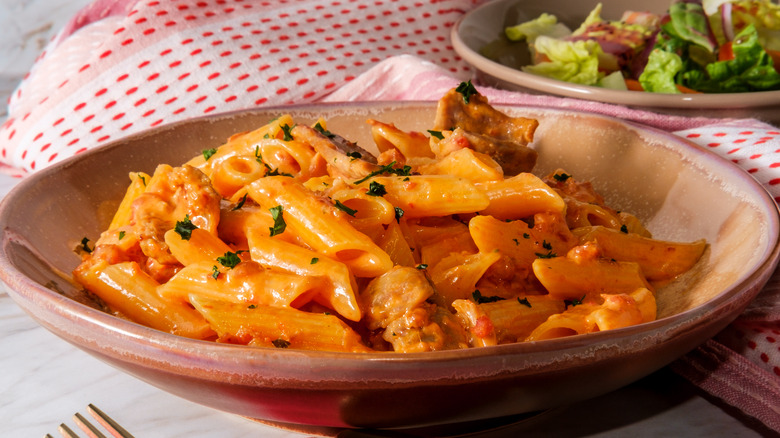Instantly Tame Overly Acidic Tomato Sauce With A Touch Of Cream
Homemade pasta sauce with fresh pasta is a delicious and simple meal. The combination of tomato sauce and pasta is a centuries-old invention that originated in Italy during the 1500s after the colonization of the Americas, which introduced tomatoes and peppers to Italian cuisine, writes Paesana. Pasta dishes have been common in Italy since the 1100s when Middle Eastern traders introduced pasta to the region. Since then, people worldwide have been enjoying the tasty combination of tomato sauce and pasta.
However, many pasta lovers are discouraged by the overly acidic and bitter taste that can ruin their homemade tomato sauces. Some of the most common ingredients in pasta sauce, like tomatoes, garlic, and onions, are all high in acidity. Worse, overly acidic tomato sauce may trigger gastronomical conditions, warns Livestrong. However, there are ways to reduce pasta sauce's acidity. Common tactics include using fresh tomatoes over tomato puree and tomato paste, which rank as the most acidic of all tomato products. Other tricks for reducing pasta sauce's acidity are hotly debated. Southern Living and Livestrong suggest a pinch of baking soda to lower pH whereas Epicurious swears by sugar to even out the taste.
When you've tried all of the best ways to fix bitter tomato sauce but nothing works, the Queen of all things domestic, Martha Stewart, has her own suggestion.
Add a touch of cream to your pasta sauce
Martha Stewart offers her own delicious solution to overly acidic pasta in her five-ingredient pasta recipe. She suggests using a splash of heavy cream to cut the acidity. While this strategy makes the sauce a little heartier, she paired it with a cold-weather pasta like gnocchi. However, she does state that the sauce is easily enjoyed with any pasta variety. Add the heavy cream five minutes before your sauce is ready for the ideal thickness and taste.
Italian food purists may scoff at adding cream to pasta sauce. And they're right; creamy pasta dishes are not authentically Italian, explains The Cut. It turns out that the classic creamy pasta dish, fettuccine alfredo, actually didn't originally include a single drop of cream. A restaurant in 1920s Rome, aptly named Alfredo's, can be credited for the dish. Even so, just because creamy pasta is not authentic doesn't mean it isn't delicious. And while your creamy tomato pasta may not be authentically Italian, it will be deliciously Italian American.

